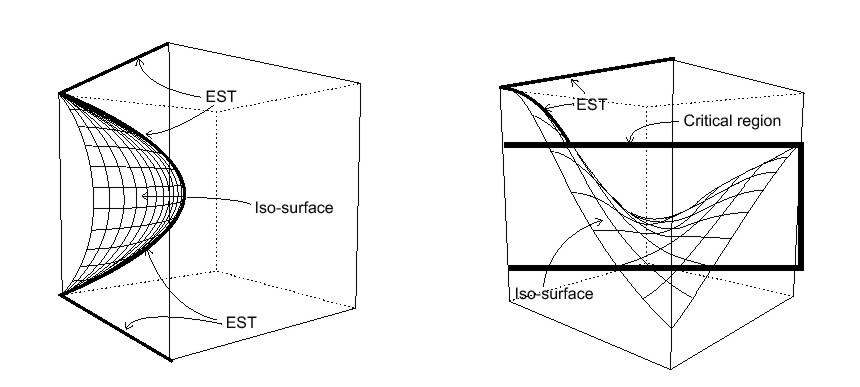
|

|
To make the concept of early scan line termination more effective, the rasterization algorithm can be adapted according to the geometry of the iso-surfaces inside the macro-cell to allow also scan lines being processed from right to left, or treating pixel columns as scan lines and processing them from top to bottom or bottom to top. If, for example, scan lines are processed from bottom to top in the example on the right hand side in figure 4, all scan lines can be terminated early.
EST does a good job reducing the numbers of local rays per pixel. Figure 5 shows a snap shot from a virtual flight through a human trachea. Figure 6 depicts the numbers of local rays per pixel needed for rendering this image using cell-based first-hit ray casting both with and without EST. The brighter the color of a pixel, the more local rays were cast at that pixel. The wire-frame-like appearance of the image on the right is due to the fact that local rays, which initiate EST, leave the pixel blank. Thus, at pixels at which EST is performed at least one more local ray must be cast. In this example, EST reduces the average number of local rays per pixel from 2.803 to 1.143, which saves, for an image resolution of 512×512, about one second of rendering time for the frame.
![\includegraphics[width=130mm]{vergleich.eps}](images/vergleich.jpg)
|
The decision, as to whether a surface cell can be considered unsafe and its projection should be included in the critical region, is based on calculating a representative normal vector for the iso-surface inside the surface cell and testing its direction in screen space. Since a representative surface normal might describe a part of an iso-surface too inaccurately, critical parts of the iso-surface might fail to be detected. Thus, EST can still lead to parts of iso-surfaces being missed. This results in holes in the iso-surface which can be detected after the regular computation of a frame, and filled. The exact criteria for surface cells being considered critical and the hole recovery algorithm are described in the master's thesis about cell-based first-hit ray casting [13].